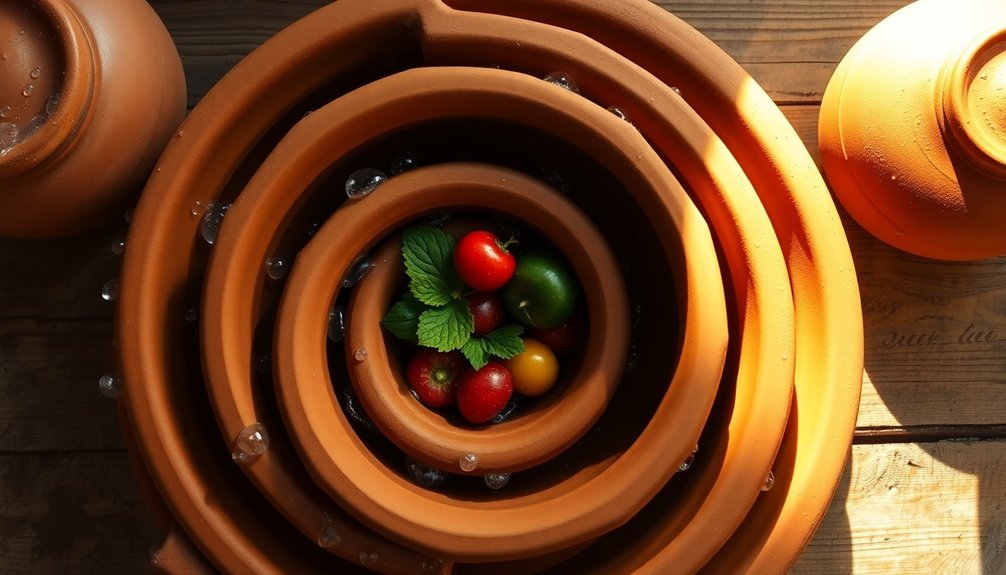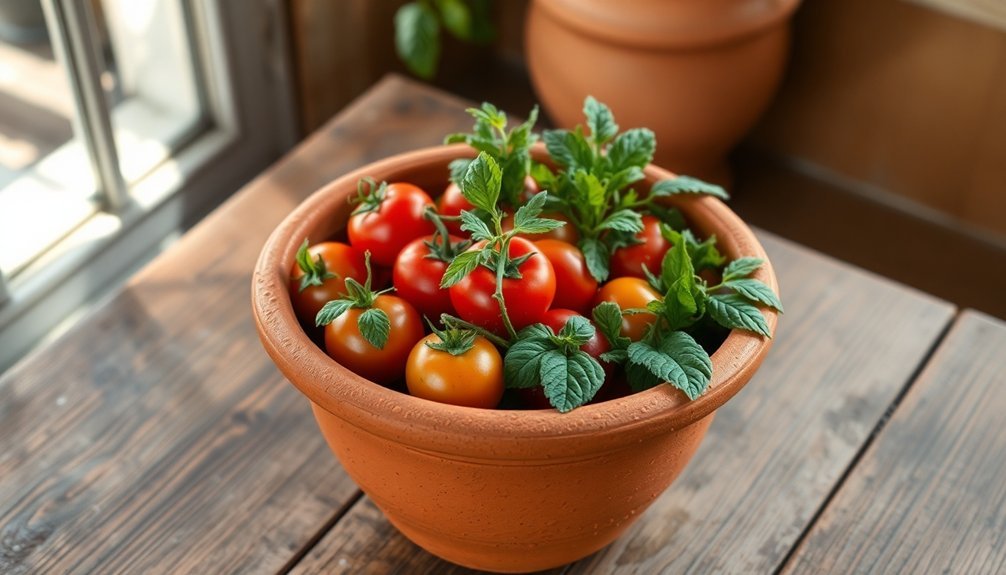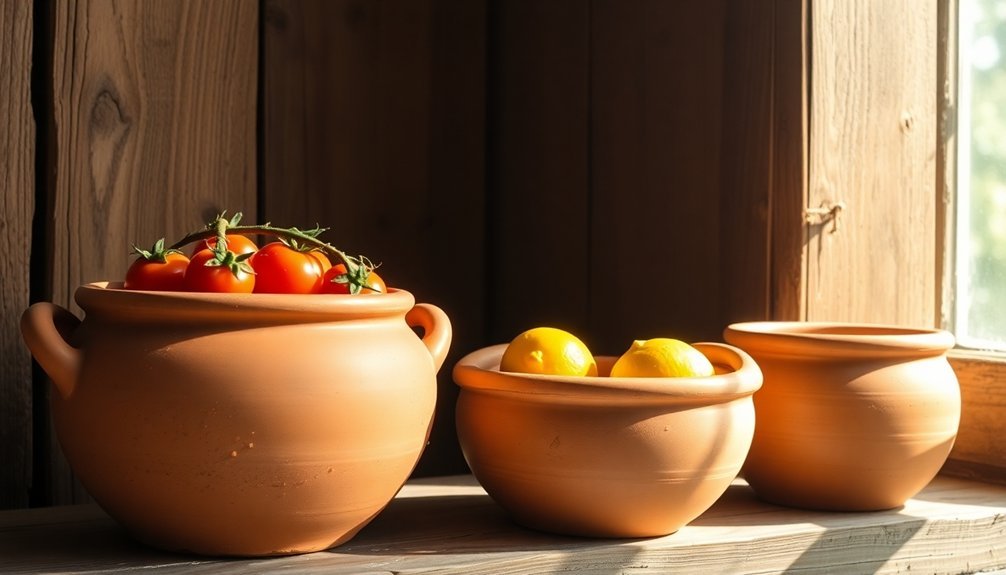Clay pot food storage offers you 5 remarkable benefits you won't find with modern containers. You'll enjoy natural cooling that can lower temperatures by up to 10°C without electricity, while the porous clay material infuses your food with essential minerals like iron and magnesium. Your fruits and vegetables will stay fresh longer, with leafy greens lasting up to 4 days instead of just one. You'll also appreciate the enhanced natural flavors and complete freedom from harmful chemicals like BPA and phthalates. These traditional vessels hold even more ancient wisdom waiting to revolutionize your food storage approach.
Natural Cooling Without Electricity

Harnessing the power of evaporative cooling, clay pot food storage offers an ingenious way to keep your produce fresh without electricity. Just like how your body cools itself through sweating, these pots use water evaporation from their outer surface to reduce interior temperatures by up to 10°C below the surrounding environment.
Research shows that this simple innovation can turn leafy greens' shelf life from one day to over four days. You'll need two pots with a layer of wet sand between them to create this natural cooling system. The setup's effectiveness depends on maintaining proper moisture levels and placing your cooler in the right location. You'll get the best results by keeping it in a shaded, well-ventilated area and covering it with a damp cloth.
The system's simplicity makes it incredibly cost-effective, with setup costs ranging from just $5 to $40 using locally available materials. You won't need to worry about electricity bills or mechanical maintenance. Instead, you'll only need to keep the sand wet and clean the interior regularly.
This natural cooling method creates an ideal humid environment for your produce, helping you preserve fruits and vegetables like tomatoes, leafy greens, eggplant, and okra for longer periods while saving money on frequent market trips.
Nutrient Preservation Through Clay
Beyond keeping food cool, clay pots offer remarkable nutrient preservation capabilities through their unique material properties. The porous nature of clay guarantees even heat distribution and moisture retention, helping preserve the natural flavors and nutritional content of your food. You'll find that nutrients are better retained compared to other cooking vessels, making it easier for your body to absorb essential vitamins and minerals. The pottery's natural composition promotes ideal slow cooking, allowing flavors and nutrients to develop fully over time.
| Clay Pot Benefits | Impact on Food |
|---|---|
| Mineral Infusion | Natural enrichment with phosphorus, iron, and magnesium |
| Non-Reactive Surface | Prevents chemical leaching and preserves original nutrients |
| Reduced Oil Usage | Lower fat content and healthier cooking results |
| Even Heat Distribution | Better nutrient retention through uniform cooking |
When you cook with clay pots, you're also benefiting from their natural mineral composition. These vessels gradually infuse beneficial minerals into your food during the cooking process, enhancing its nutritional value. You won't need to worry about chemical reactions either, as clay's non-reactive nature guarantees your food maintains its original nutritional properties. Plus, you'll use less oil in your cooking, making your meals healthier while maintaining their nutritional integrity.
Earth-Fresh Flavor Enhancement

Through out the ages, clay pots have been celebrated for their remarkable ability to enhance food's natural flavors. When you store your food in clay containers, you'll notice a distinctive earthy taste that's impossible to achieve with modern storage options. The porous nature of clay allows it to interact with your food, creating a unique flavor profile that enhances both taste and aroma. Traditional culinary practices across generations have proven clay pots superior for taste enhancement.
You'll find this enhancement particularly noticeable in dairy products like curd and buttermilk. Clay pots create the perfect environment for fermentation, improving the taste of foods like sauerkraut, kimchee, and fermented rice. The natural moisture and air circulation through the clay's pores prevent your food from becoming stale while maintaining its aromatic properties.
The pot's evaporative cooling mechanism doesn't just preserve your food – it actively contributes to its flavor development. You'll discover that fruits and vegetables stay fresher longer, and their natural tastes become more pronounced.
This traditional storage method, deeply rooted in cultures worldwide, continues to prove its worth through its ability to transform ordinary foods into more flavorful, aromatic versions of themselves.
Zero Environmental Impact
Sustainability shines through every aspect of clay pot food storage. When you use these traditional cooling systems, you're actively contributing to environmental preservation without compromising functionality.
Clay pot coolers operate completely off-grid, requiring no electricity while effectively preserving your fruits and vegetables through simple evaporative cooling.
The environmental benefits are substantial and measurable:
- You'll help reduce the 4.4 Gt of CO2 emissions generated annually from food waste – an amount comparable to global road transport emissions.
- You're supporting local economies and reducing transportation emissions by using locally sourced materials like clay, sand, and water.
- You'll decrease the need for energy-intensive food production by extending the shelf life of your produce.
In hot, arid regions, you're not just storing food – you're building climate resilience.
The system's zero-energy operation eliminates dependency on fossil fuels, while its minimal resource requirements make it an accessible solution for communities worldwide.
Chemical-Free Food Safety

Safety meets nature in clay pot food storage, offering you a completely chemical-free solution for preserving your food.
Unlike plastic containers that can leach harmful substances, clay pots won't release any toxic chemicals into your meals, especially when storing acidic or fatty foods that typically accelerate chemical transfer.
You'll find that clay's natural composition eliminates concerns about BPA, phthalates, and other harmful substances commonly found in plastic containers.
There's no need for non-stick coatings either, as clay provides a naturally safe cooking and storage surface.
When you store food in clay pots, you're protecting both its nutritional value and original flavor.
Clay pots offer superior hygiene compared to plastic alternatives.
They're less likely to absorb bacteria, odors, or food particles, making them easier to maintain and more suitable for long-term storage.
You won't have to worry about lingering smells or residue contaminating your food.
Frequently Asked Questions
How Do You Properly Clean and Sanitize Clay Pots Between Uses?
Scrub your clay pot with salt and baking soda, then boil water inside with baking soda to sanitize. Add lemon slices for stubborn odors. Don't use soap, as it'll absorb into clay. Dry thoroughly.
Can Clay Pots Be Used in Modern Ovens and Microwaves?
Yes, you can safely use clay pots in both modern ovens and microwaves. They'll regulate heat well in ovens, adding about 10 minutes to cooking time, and they're microwave-safe for convenient reheating and cooking.
What Types of Foods Should Not Be Stored in Clay Pots?
You shouldn't store ethylene-sensitive foods, strong-smelling items like garlic and onions, or high-humidity produce in clay pots. These foods can spoil quickly or affect other items' flavors and ripening processes.
How Long Does a Clay Pot Need to Be Seasoned Before First Use?
You'll need to season your clay pot for at least 24-48 hours before first use. This includes soaking for 18-24 hours, drying completely, then applying oil or following another seasoning method of your choice.
Do Clay Pots Work Equally Well in All Climate Conditions?
No, your clay pot won't work equally well everywhere. They're most effective in hot, dry climates where water evaporates quickly. You'll see reduced performance in humid areas where evaporation is limited.
In Summary
You'll find that clay pot storage offers a revitalizing return to time-tested food preservation methods. Not only will you save on electricity and reduce your carbon footprint, but you'll also enjoy better-tasting, nutrient-rich foods without chemical preservatives. Whether you're storing fruits, vegetables, or grains, these ancient vessels provide a sustainable, healthy alternative to modern storage solutions while keeping your food naturally fresh and flavorful.





Leave a Reply